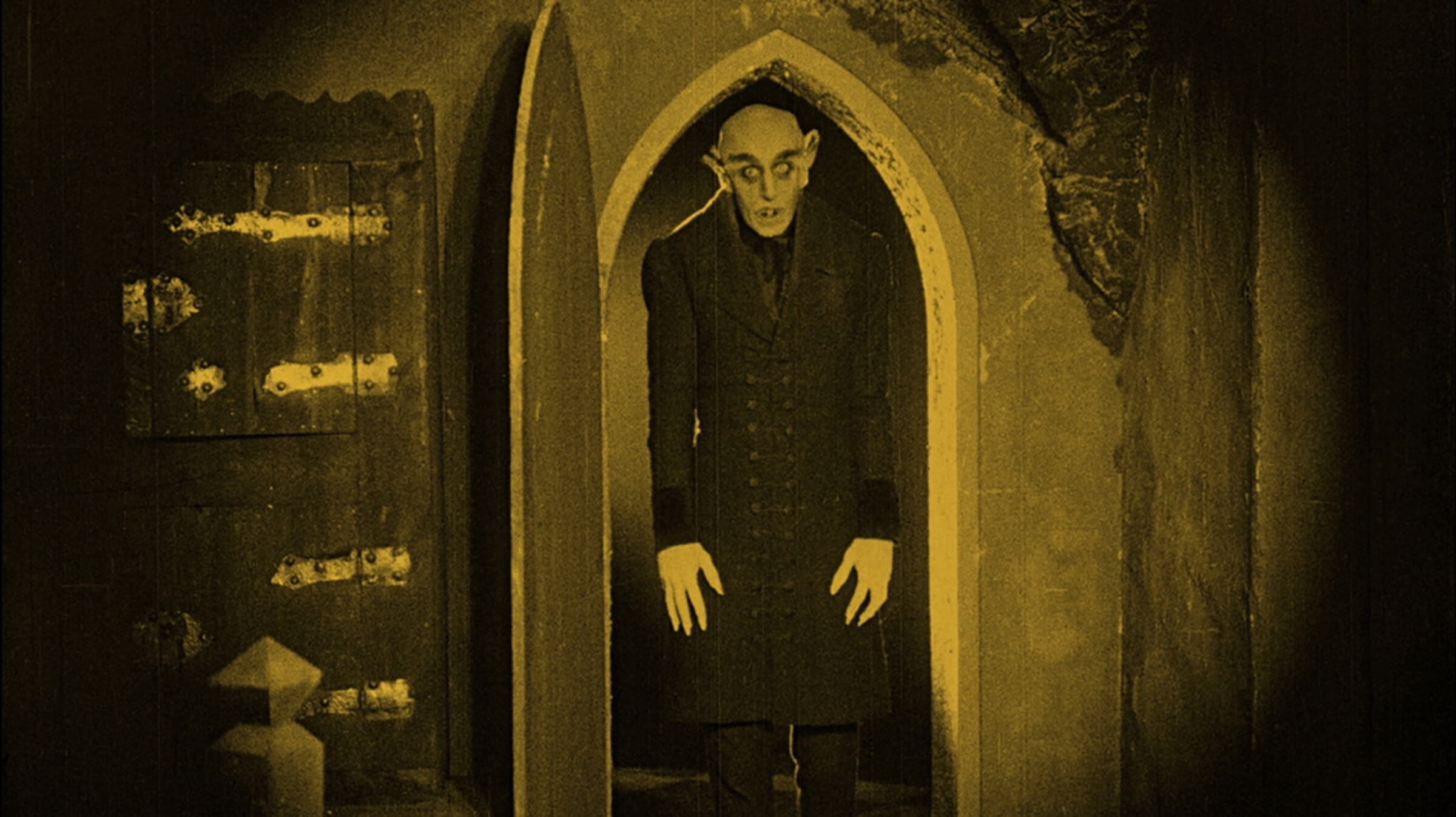There’s an image from F.W. Murnau’s Nosferatu that I can’t shake: a pallid, pointy-eared ghoul stares down at a camera that is positioned below the deck of a ship whose ropes and mast are shooting skyward behind him, framing his figure to evoke a kind of authoritarian menace. And then there’s his hands: curled like talons, preparing to swipe. You’re probably familiar with this scene if you know anything about Murnau’s early masterpiece. This single frame remains indelible for a good reason—it encapsulates the film’s stillness and eeriness, which are key to its hold on us—as Roger Ebert once said of Nosferatu’s particular spell: “It doesn’t scare us, it haunts us.”
Of the twenty-one films Murnau directed before his untimely death at the age of forty-two, eight remain lost, a fate that very nearly befell Nosferatu, his tenth film shot in Germany, and arguably his most widely beloved. At the time, Bram Stoker’s 1897 novel wasn’t exactly fair game to adapt, and shortly after the film’s release, the writer’s widow sued the fledgling production company, Prana Film, for copyright infringement. Prana, however, had already gone bankrupt, so, as there was no big payout for Mrs. Stoker, the court ordered all copies of Nosferatu destroyed. Luckily, several had made it safely to other jurisdictions by then. (Most of the original score by Hans Erdmann, on the other hand, was lost after the film’s premiere; most home video releases of Nosferatu use partial reconstructions of Erdmann’s composition.)
Three of Murnau’s later films, The Last Laugh (1924), Sunrise: A Song of Two Humans (1927) and Tabu, A Story of the South Seas (1931), rival Nosferatu in terms of critical acclaim and film-historical significance. But neither really comes close to Nosferatu’s sprawling cultural legacy, which extends to several remakes (most recently one by Robert Eggers) and a creepy cameo in an episode of SpongeBob Squarepants. That American critics panned Murnau’s monster movie when it showed in the U.S. several years after its German release feels like a blip in its otherwise seemingly eternal lifespan.
Nosferatu was not only the first film to adapt Dracula for the screen; it was the first true vampire film, ever, and it established some ground rules (such as the ghoul’s vulnerability to sunlight) that are still received as sacred Gothic lore. Still, Orlok, as embodied by Max Schreck—a reclusive theater actor who was cast, in part, because of his height (six foot two)—is quite unlike the cinematic vampires we’ve become accustomed to. He’s not a sexy, cape-wearing bloodsucker—more like an egg-headed extraterrestrial with claws. Neither does Murnau employ any of the conventional vampire movie’s lurid thrills; his approach is moody, oneiric, and misty with obscene ambiguities, a tone and style that perhaps is only matched by Carl Dreyer’s Gothic horror film Vampyr from 1932.
Released in Germany in 1922—four years after the end of World War I, amid ongoing tensions between the Weimer Republic’s dominant Social Democratic Party and extremists on the right and the left—Nosferatu conjured the country’s spiritual angst. According to legend, Murnau was convinced to make the film by his producer and production designer Albin Grau, who’d heard Serbian folktales about the undead while serving in the war. When the frail-looking Orlok commandeers a ship by some supernatural force of will and sails it to a sleepy German port town, he’s carrying the plague with him in the form of a deadly army of rats (the trenches’ most populous inhabitant) who are left to ravage the locals in a clear echo of postwar Germany’s devastated state.
In this, Nosferatu resembles other German Expressionist films—think Robert Wiene’s The Cabinet of Dr. Caligari (1920) or Fritz Lang’s Dr. Mabuse the Gambler (1922)—that employ nightmare imagery and fantastic distortions of reality to convey traumatic emotional effects. We see these hallucinatory tendencies in Count Orlok’s slinky, stretched-out shadows; in the cavernous arches and geometrical corridors within his castle. The demonic Orlok—an ugly embodiment of death, cruelty, and darkness—also defies space and time, appearing and disappearing like a specter in the corners of shots, or moving abnormally across the frame (with the help of undercranking and stop-motion photography techniques).
Nosferatu also stands apart from its stylized contemporaries, most obviously in its use of real-world settings: the forests of Lübeck, the Tatra mountains, a fortress in Slovakia. Here, Murnau’s preference for location shooting adds a frightening realism to the film’s paranormal elements. The foreboding natural imagery—looming mountain cliffs and rushing ocean waters—are also key to the film’s conception of horror as a kind of inexplicable, marrow-deep unease, something more akin to the intuitive evocations of song than the narrative twists of a scary story. Murnau, who as a child idolized the Romantic composer Gustav Mahler, had musical inclinations, which are evident in the film’s rhythms and movements. Human action is intercut with lyrical images of bells tolling and winds gusting through trees and clothing. The film’s subtitle even evokes a musical composition: Nosferatu: A Symphony of Horror.
In the style of a Grimms fairytale or a Gothic fantasy by E.T.A. Hoffman, Nosferatu tells the story of a young couple whose happiness is shattered by nefarious subterranean forces embodied by Orlok. Thomas Hutter (Gustav von Wangenheim), a naïve real estate agent, is tricked by his employer, the vampire’s mad minion Knock (Alexander Granach), into taking a long journey to the count’s castle in faraway Transylvania, leaving his virginal wife Ellen (Greta Schröder) behind to anxiously pine over him. The push and pull between temptation and responsibility, as well as a spoilt innocence reminiscent of Adam and Eve’s ejection from the Garden of Eden, can be seen throughout Murnau’s body of work, particularly in Sunrise, which has a married man temporarily run off with a flapper type.
In Murnau’s earliest surviving film, Journey into the Night (1921), a famed doctor is seduced by a dancer, but an element of mysticism in the form of a blind painter is introduced to disrupt their blissful illusion. Nosferatu, in turn, exposes its happy couple to Orlok, who catches sight of Ellen’s likeness in Hutter’s locket and exclaims: “Your wife has a pretty neck!” The vampire is overcome by a hunger for Ellen and buys a property directly across from the Hutter’s household. After escaping the castle, Hutter travels back home by land, while Orlok goes by sea, in what is basically a classic chase scene to reach their beloved Ellen. Yet, however tempting it is to view the film’s tensions as a battle of good versus evil, such a reading ignores the film’s sustained ambivalence. As Murnau shifts between Hutter and Orlok’s journeys, we see Ellen staring out at the water, her nightgown blown by the sea breeze, already caught in the vampire’s mysterious field of gravity.
German Expressionist films routinely take cues from Gothic literature’s tropes and symbols, particularly that of the doppelganger. Nosferatu is no exception. Hutter and Orlok are opposite sides of the same coin: one is an impotent husband; the other, a godlike, if gruesome, aristocrat. In the end, Ellen’s martyrdom doubles as a capitulation to her own perverse desires; while ridding the world of the vampire’s pestilence, she is also breaking out of her domestic chains. It’s a tragedy with a cynical worldview. The demon dies, but so, too, does the sparkling dream of the bourgeois family—reality, a churning realm of fraught impulses and vulnerable souls, could never sustain such whimsies.
Beatrice Loayza is a Brooklyn-based writer who contributes regularly to the New York Times, Artforum, Film Comment, Sight and Sound, and the Criterion Collection.

